Randy, I wouldn't want to wrestle that saw very long and I certainly couldn't wrestle the sawyer very long. I thought a gear drive with a bow was heavy - actually a light weight in comparison I assume. Ron
You are using an out of date browser. It may not display this or other websites correctly.
You should upgrade or use an alternative browser.
You should upgrade or use an alternative browser.
McCulloch Chain Saws
- Thread starter Bruce Hopf
- Start date

Help Support Arborist Forum:
This site may earn a commission from merchant affiliate
links, including eBay, Amazon, and others.
Laying aside for purposes of discussion the "if it ain't broke don't fix it" principle, at just what compression psi would you recommend ring replacement for a 125C with no scoring? A PM700? Thanks, Ron
NOS 125 parts
A while back i reported that I had purchased some major NOS 125 parts ... as they say if it sounds too good to be true it isn't. Although my seller has always delivered in the past with some great NOS 125 pieces (chain brake, mufflers & clutch), he failed miserably this time with an out of date inventory sheet. No piston and cylinder, no handle/tank, and no chain brake type handle bar. A lot of wasted time with calls and emails as they tried to find replacements. :msp_sad: Now if I could just find a NOS MC101B for cheap, I might be able to put this all in the past and move forward. Any help (other than psychiatric) accepted. Ron
A while back i reported that I had purchased some major NOS 125 parts ... as they say if it sounds too good to be true it isn't. Although my seller has always delivered in the past with some great NOS 125 pieces (chain brake, mufflers & clutch), he failed miserably this time with an out of date inventory sheet. No piston and cylinder, no handle/tank, and no chain brake type handle bar. A lot of wasted time with calls and emails as they tried to find replacements. :msp_sad: Now if I could just find a NOS MC101B for cheap, I might be able to put this all in the past and move forward. Any help (other than psychiatric) accepted. Ron
promac850
formerly promac610
Who sent you from the shop on this field trip anyways?
361's are 58-60cc, and while the clown was a dreamer, certainly no more so than you.
So after this little sawcation, get you back in the shop where you won't embarrass any more yellow saws. And put that PM650 back under the bench, if'n you pinch that bar one more time sos it needs to rescued by another saw, we'll find us another monkey.:msp_biggrin::msp_biggrin:
Good video, tree didn't look near that big though, and were you far enough away, or is that where they sent you?
My boss, my neighbor, my parents, and my neighbor's son in law all authorized this field expedition featuring the Shop Monkey. I was about 100 ish feet away from the tree... me, my neighbor, and his son in law, along with another neighbor were standing in a group there. Like I said, this tree was very dangerous, it could have barber chaired twisted on the stump, etc. although that likely would never happen due to the tension on the rope from the Ford pulling on it. Even so, we all took the precaution and stood back.
The 610 (not 650...) is still residing on its little table in the barn... it will not come out for this job. I did not need another saw to free my stuck 850. My neighbor simply wiggled the loose end that got trimmed down, with his foot so I could wiggle the bar out. It worked great. Now I know another little trick to getting a saw unstuck without needing a 'rescue' saw. Also, the bar still looks almost 100% brand new. I am impressed with the quality of the paint on it. The chain is wicked also, it cuts fast, and like I mentioned before, it makes nice big chips.
His son in law did say that he didn't think the 361 could pull a 32" bar... the 600 cinder block series Macs would struggle a fair bit with that big of a bar too.
Now, please quit dissing the 610... the weight of the beast is nice because you set it on a log and it'll do all of the work. Feel free to stand on it too, with the full 20" bar buried in medium hard to real hard wood... it ain't gonna slow down any more than its already slow cutting rate. Try that with a 361. I bet I could bog the thing down and stall it with the way I cut sometimes.
I had no trouble swinging the 850 around. My left bicep did miss holding that weight up the next morning though... it wanted to go back to work and keep cutting with the Mac!
I just got back from work at about 6:45... and when I picked the mail up, wow. Nice hefty little envelope... I knew something very important was in there. I ate supper when I got home, walked the pup, and did some chores... and took a shower. Man, I was soaked in sweat working out in that shop, also from walking the pup. She really likes a fast walk, slow walks simply make it all drag out, because she decides she is bored and sniffs around a lot more.
Yes, I was working in the shop today. Stuffing screens into PVC elbows, and slapping little orange stickers onto said elbows... for the vent pipe that is installed with every new Bradford-White water heater, which some of you may have in your basement or garage. Yep, that silly little elbow is all US made and assembled... Charlotte Pipe and Foundry supplies the elbows, and a forming company in Ohio supplies the 3" to 2" adapters. The screens are stamped out in house from US made wire mesh. Me and another guy turned out a pallet of boxes about 20 some inches by 16 or so inches by 10 inches... filled with precisely 50 screened and stickered elbows in each box. The pallet has about 8 or so boxes stacked high. Yep, lots of production going on here. I'm glad to be a part of it. It's nice to know that things still are done the right way, in the USA. In fact, IIRC, every part of a B-W water heater is made and assembled in the US, and the heater tank itself, and many related parts are made and assembled right here in Michigan. Trust me, you are paying for quality when you buy one of these water heaters. We have ours in the basement, installed ten years ago, without the anode (we have real hard water, for some reason, anodes can actually compromise the heater tank and parts, there is that much iron in the water...) It still works great. No problems with it whatsoever.
Going into work tomorrow morning at about 5:00... gotta leave the house at about 4:30 to arrive on time. Yep, gonna go to bed a bit earlier tonight and get up at 4:00...
We got a huge order that is supposed to be delivered tomorrow... we are making grates that trap debris from falling onto the highway (they are installing them onto the new overpasses) They consist of 1" square over sized chain link fence, and are bolted onto frames. 5/8" bolts hold it all together... supposedly electric impacts are good enough... but for ####s and giggles, I'll bring my new IR along to see if they wanna see it nail those bolts down twice as fast... It's gonna be a busy, hot, and very hard day tomorrow. Wish me luck. Maybe the IR won't tax the compressor system enough for me not to run it... (lots of the presses and such use a crap ton of compressed air, so they don't regularly use air tools like die grinders, etc.)
Gonna go to bed pretty soon here... hour from now, tops... not gonna stay up past 10:30... I need my rest.
Ron, I cannot believe what you sent me is what you sent me... I am flabbergasted beyond proportions of the typical human mind's capability of understanding. (read: the mind of a driver that texts while driving, causing mayhem and death and destruction everywhere they go... man, they are everywhere...) Thanks, again... If there is any way for me to repay you, please ask. I'm simply astounded by this gift. (fellow Mac fans, I will post pics tomorrow after I get home from work)
Sorry about the rambling, Sir Emperor, Duke of Theirry, and Magnesium Junkie. As well as 8433jeff... hope this weekend I will get to continue my field expedition and finish off that maple. Complete with vids and photos.
I managed to spend a few minutes on the 77 project tonight, I now have most everything cleaned up and starting to go back together. WE HAVE SPARK! I don't remember any other saw having such a fat, blue, snappy spark even at low RPM. Perhaps by Saturday I can try to put a little fuel and air together with the spark and see what happens...
I promise a few photo's in a day or two.
Mark
I promise a few photo's in a day or two.
Mark
Eccentric
Mister Wizard
I managed to spend a few minutes on the 77 project tonight, I now have most everything cleaned up and starting to go back together. WE HAVE SPARK! I don't remember any other saw having such a fat, blue, snappy spark even at low RPM. Perhaps by Saturday I can try to put a little fuel and air together with the spark and see what happens...
I promise a few photo's in a day or two.
Mark
Glad to see you're working on the 77 again. Not surprised by the quality of spark you're getting out of that saw. The old beast had a powerful spark when I had it. Lit on a prime every time too. Once you square away the carb, you'll have a strong runner.

$337.83
$369.99
WEN Electric Log Splitter, 6.5-Ton Capacity with Portable Stand (56208)
Amazon.com

$59.99 ($0.40 / Foot)
$69.79 ($0.47 / Foot)
Arborist Rigging Rope 1/2 in x 150 Ft Blue Bull Rope Polyester Braided Arborist Rope 1/2 inch 48 Strands 150 Feet for Various Outdoor Applications Construction Climbing Swing Sailing
Glfcai store

$79.99
ZELARMAN Chainsaw Chaps 8-layer Protective Apron Wrap Adjustable Chainsaw Pants/Chap for Loggers Forest Workers Class A
QUALITY GARDEN & HAND TOOLS

$215.05
$233.19
Weaver Leather WLC 315 Saddle with 1" Heavy Duty Coated Webbing Leg Straps, Medium, Brown/Red
Amazon.com

$202.29
Oregon Yukon Chainsaw Safety Protective Bib & Braces Trousers - Type A Protection, Dark Grey, Large
Express Shipping ⭐⭐⭐⭐⭐

$19.99 ($3.33 / Count)
Firewood Log Splitter 45mm+32mm + 4 Handles (Square + Round + Hex Shank + Small Hex) Wood Log Splitter Easy Splitter Detachable Drill Bit Heavy Duty Electric Drills Screw Cone Driver Removable
JianShiMoQinDianZiShangWuYouXianGongSi

$26.99 ($0.22 / Foot)
$29.99 ($0.25 / Foot)
VEVOR Double Braided Polyester Rope, 1/2 in x 120 ft, 48 Strands, 8000 LBS Breaking Strength Outdoor Rope, Arborist Rigging Rope for Rock Hiking Camping Swing Rappelling Rescue, Orange/Black
Amazon.com

$225.16
OREGON 295397 Type C (All Round Yukon Chainsaw Protective Trouser, Black, Small
Express Shipping ⭐⭐⭐⭐⭐

$63.99
ZELARMAN Chainsaw Chaps Apron Wrap 8-layer for Men/Women Loggers Forest Workers Protective Chain Saw Pants Adjustable
QUALITY GARDEN & HAND TOOLS

$56.99 ($0.38 / Foot)
$69.99 ($0.47 / Foot)
Arborist Rigging Rope Bull Rope Black (1/2 in x 150ft) Polyester Braided Arborist Rope 48 Strands for Tree Work Camping or Swinging…
UIERTIO
Anyone very interested a nice PM 700, I have a couple on trading post and I updated the ad.
They do have a very nice powerband.
They do have a very nice powerband.
ChainsawmanXX
Addicted to ArboristSite
Worked on my 250 parts saw I got last night and I got it running. I got alittle bit more work on it, but it looks beautiful how do I know if its a super or a 250? It says just 250 on the bottom of the case Thinkin I still need to clean out the carb on it but started on prime 
She sure is beautiful though :jester:
She sure is beautiful though :jester:
Warped5
WingNut
Anyone very interested a nice PM 700, I have a couple on trading post and I updated the ad.
They do have a very nice powerband.
John - You really want to post that saw in the classifieds w/pics. Waaay too good looking not to.
Worked on my 250 parts saw I got last night and I got it running. I got alittle bit more work on it, but it looks beautiful how do I know if its a super or a 250? It says just 250 on the bottom of the case Thinkin I still need to clean out the carb on it but started on prime
She sure is beautiful though :jester:
Your is a 250. The Super 250 would have a more detailed model number stamped on the bottom of the crankcase in place of the 250 stamp.
Mark
bafarm
ArboristSite Member
7-10A comp release repair
Good Morning,
I just picked up this saw and the Comp. release threads are stripped in the head.
Any Ideas on what works or does not work to fix this?
Thanks in advance, Don
Good Morning,
I just picked up this saw and the Comp. release threads are stripped in the head.
Any Ideas on what works or does not work to fix this?
Thanks in advance, Don
Good Morning,
I just picked up this saw and the Comp. release threads are stripped in the head.
Any Ideas on what works or does not work to fix this?
Thanks in advance, Don
Wow that sucks. I wonder how that happened? Probably the best bet would be to tig weld some extra material in there, and then drill it out and re tap the hole. You need some serious equipment to do that job though. Otherwise you could go up a size and tap it and install a bolt to plug it. The 7-10 can be started without the decomp. Either way, the metal chips could mess up the piston and rings so pull the muffler and blow it out real good before you are finished. Spray it out with some carb cleaner as well.
Sad thing is that for the amount that a 7-10 is worth, fixing it does not really make financial sense. You might be better off looking for another one and using this one as the parts saw. My 7-10 runs awesome and I bought it for about $120 on Ebay. I had to replace the oil reservoir on it, but other than that it was good.
Here are some pictures and a video. I repainted it and changed the reservoir, but other than that it was fine.
chainsaw :: 005-1.mp4 video by jmueller57 - Photobucket
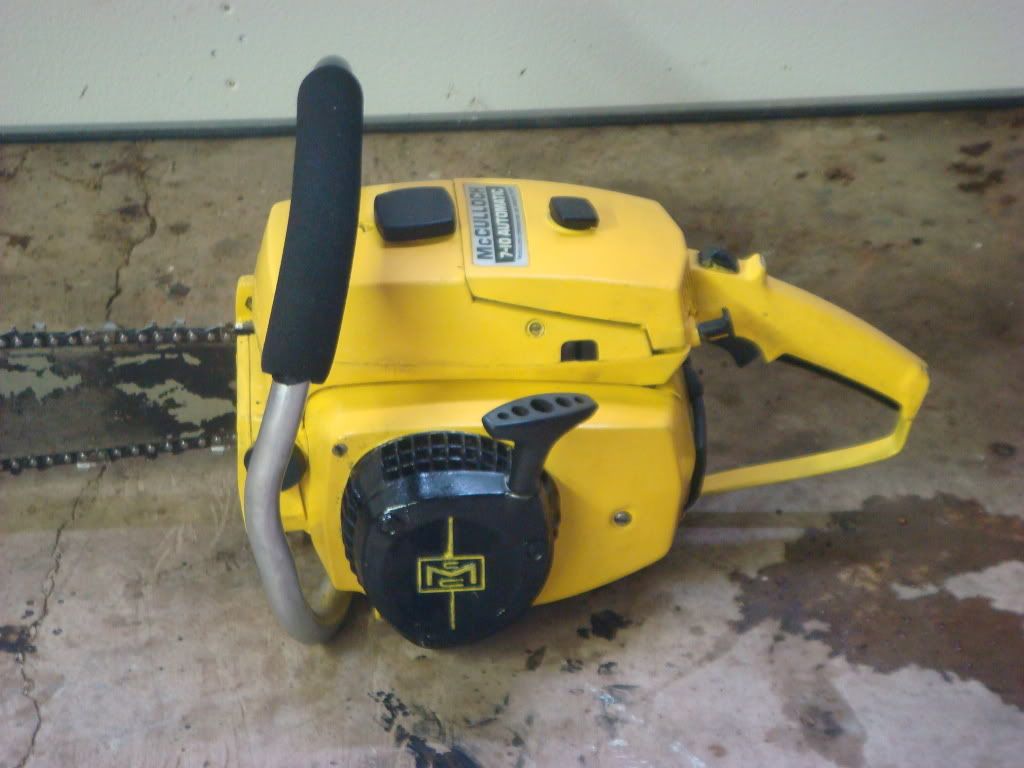
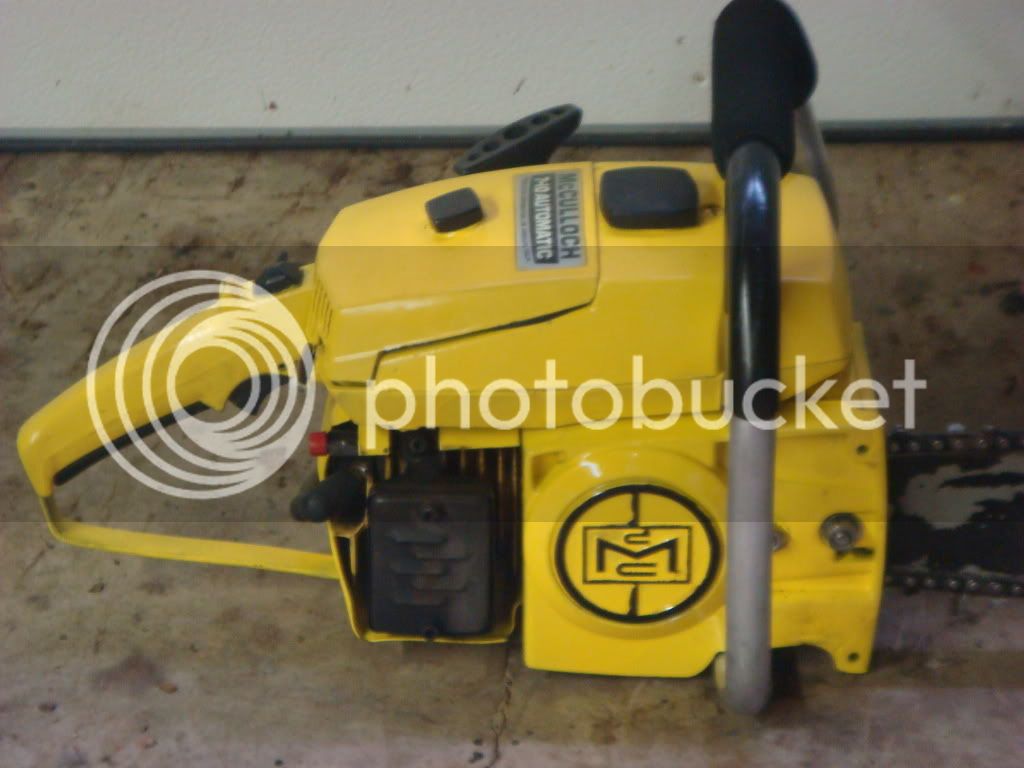
Picked up this big son-of-a-gun the other day off Ebay. All things considered, a pretty fair price. I added the helper handle but the rest was part of the deal. All the badging on the tank is gone. Supposed to run but needs tuning--the last picture will make clear why.
By the way, how in the world is the carb on this thing supposed to be adjusted and preset? Quite a departure from what I'm used to.
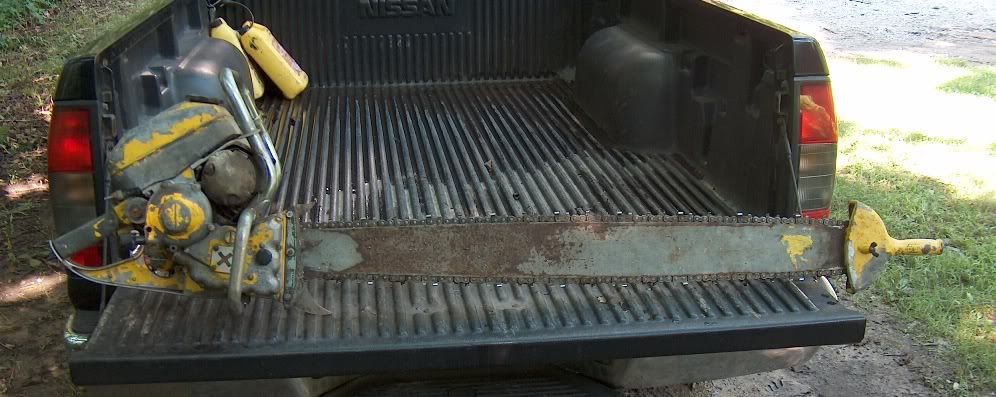
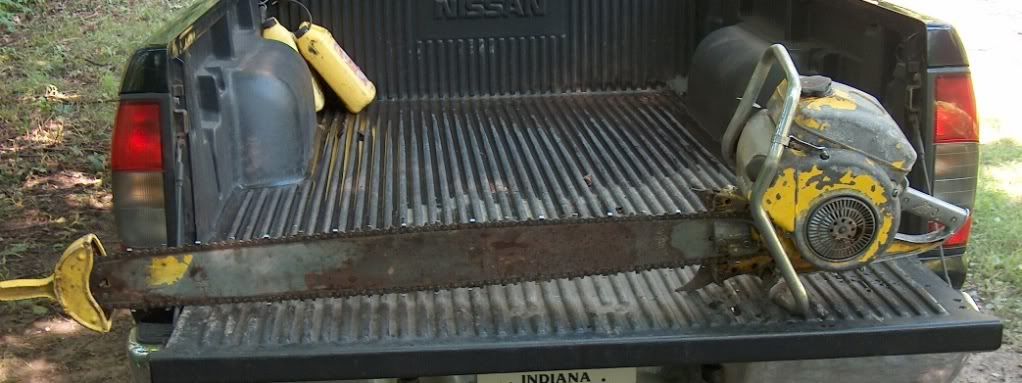
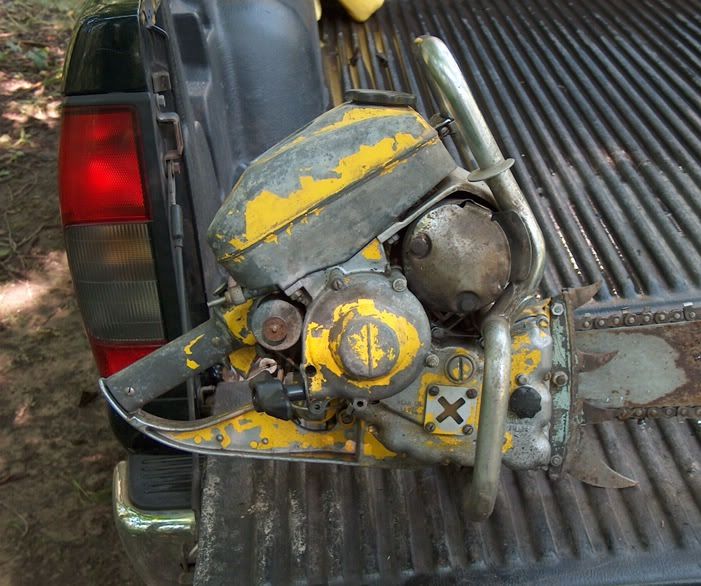
Chain throw has put a very small hole in the crankcase. I think this can be easily patched without much disassembly.
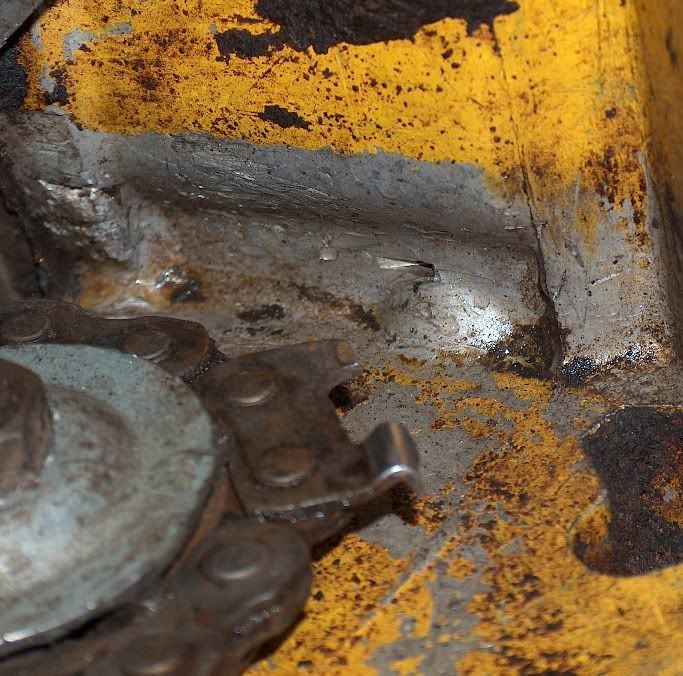
Chris B.
By the way, how in the world is the carb on this thing supposed to be adjusted and preset? Quite a departure from what I'm used to.



Chain throw has put a very small hole in the crankcase. I think this can be easily patched without much disassembly.

Chris B.
Eccentric
Mister Wizard
You're in for a 'treat' Chris. Nice score. Looks to be a McCulloch 73. The model # will be cast into the left side of the rear handle (I can barely see it in the pic). There should also be a pad cast into the lower part of the rear handle bracing/webbing area with the model and serial # stamped into it. Should look something like "73-12345" with the 73 being the model #. That's how the 77 I sent to Mark was labled. Your 73 is the older brother. Both are 7.3ci/120cc. The 77 has a different tank design (shared with the 49). The carb design is different too, as is the air filter. On these saws, the kill switch is a push/pull knob on the top of the flywheel cover near the handlebar. Pull out for run. Push in, and a tab grounds out the coil.
The carb 'system' on these saws (47, 49, 73, 77, and others I don't remember) consists of a pulse driven fuel pump inside the fuel tank, a metering section WAY down low in front of the rear handle, and a venturi/jet/throttle body assembly that's part of the rear handle/crankcase casting. Fuel is pumped up from the tank wick, passed over and down to the metering section, then drawn up into the throttle body/ventury/jet thingee. Air is drawn from the AF (to the right of the throttle body on your saw), through the throttle body/venturi (where fuel is mixed in), then continues left into a manifold casting (under the flywheel) where it hangs a 180 deg turn and goes left-right through the rotary valve into the crankcase. Crazy, Rube Goldberg stuff. There's a sepperate plunger primer pump on the bottom right of the tank body. The HS mixture needle has a knob that's on the top/front of the rear handle casting. The idle mixture needle is a regular screw-type, and is on the metering body.
On the 77, it draws air down through a 'normal' square McCulloch filer (the steel AF cover and the filter interchanges with a 44/55 saw...........I once saw a 77 labled cover on a 44). The air then hangs a 90deg turn to the left and goes right-left through the throttle body/venturi thingee and continues on through the rotary valve as with your 73. The 77 has a spring loaded, ratcheted thumb lever that allows you to easily adjust the HS mixture on the fly. Not sure if the 73 does too. Can't see in your pic. That HS needle is about 3.5" long by the way. Goes from the top of the handle/venturi/throttle body down into the metering section. They also has a knob below and in front of the trigger on the right side of the rear handle. It turns a cam that raises and lowers the idle speed. You can dial in a high idle for starting, then turn it back down where you want it once the saw's warm. Turning the knob continuously will make the trigger move back and forth, back and forth. The pulse driven fuel pump is powered by an alluminum impulse tube with spring loaded seals on each end between the crankcase and the lower fuel tank casting.
These saws cost over $500 back in the mid-50's. That'd be something like $4000 today. You can see why once you take it apart. The casting and machining on these saws is fantastic. There's about 123,490 parts in them. They're like a WWII German aircraft engine or MG34 machine gun. An exercise in manufacturing and design excess. I think Mark's saw has such great spark at low RPM's because the flywheel is about 6' in diameter! The linear speed of the magnet past the coil is about 50 MPH at 50 RPM's cranking speed.
Dang Chris............I just noticed that your 73 has what looks to be an H&S bucking spike. Too cool!
The 77 I sent Mark had a loop of Oregon 16C 5/8" chipper on it. Those saws could have had 1/2", 9/16", or 5/8" chain.
The carb 'system' on these saws (47, 49, 73, 77, and others I don't remember) consists of a pulse driven fuel pump inside the fuel tank, a metering section WAY down low in front of the rear handle, and a venturi/jet/throttle body assembly that's part of the rear handle/crankcase casting. Fuel is pumped up from the tank wick, passed over and down to the metering section, then drawn up into the throttle body/ventury/jet thingee. Air is drawn from the AF (to the right of the throttle body on your saw), through the throttle body/venturi (where fuel is mixed in), then continues left into a manifold casting (under the flywheel) where it hangs a 180 deg turn and goes left-right through the rotary valve into the crankcase. Crazy, Rube Goldberg stuff. There's a sepperate plunger primer pump on the bottom right of the tank body. The HS mixture needle has a knob that's on the top/front of the rear handle casting. The idle mixture needle is a regular screw-type, and is on the metering body.
On the 77, it draws air down through a 'normal' square McCulloch filer (the steel AF cover and the filter interchanges with a 44/55 saw...........I once saw a 77 labled cover on a 44). The air then hangs a 90deg turn to the left and goes right-left through the throttle body/venturi thingee and continues on through the rotary valve as with your 73. The 77 has a spring loaded, ratcheted thumb lever that allows you to easily adjust the HS mixture on the fly. Not sure if the 73 does too. Can't see in your pic. That HS needle is about 3.5" long by the way. Goes from the top of the handle/venturi/throttle body down into the metering section. They also has a knob below and in front of the trigger on the right side of the rear handle. It turns a cam that raises and lowers the idle speed. You can dial in a high idle for starting, then turn it back down where you want it once the saw's warm. Turning the knob continuously will make the trigger move back and forth, back and forth. The pulse driven fuel pump is powered by an alluminum impulse tube with spring loaded seals on each end between the crankcase and the lower fuel tank casting.
These saws cost over $500 back in the mid-50's. That'd be something like $4000 today. You can see why once you take it apart. The casting and machining on these saws is fantastic. There's about 123,490 parts in them. They're like a WWII German aircraft engine or MG34 machine gun. An exercise in manufacturing and design excess. I think Mark's saw has such great spark at low RPM's because the flywheel is about 6' in diameter! The linear speed of the magnet past the coil is about 50 MPH at 50 RPM's cranking speed.
Dang Chris............I just noticed that your 73 has what looks to be an H&S bucking spike. Too cool!
The 77 I sent Mark had a loop of Oregon 16C 5/8" chipper on it. Those saws could have had 1/2", 9/16", or 5/8" chain.
Last edited:
You're in for a 'treat' Chris. Nice score. Looks to be a McCulloch 73. The model # will be on the left side of the rear handle (I can barely see it in the pic). There should also be a pad cast into the lower part of the rear handle bracing with the model and serial # stamped into it. Should look something like "73-12345" with the 73 being the model #. That's how the 77 I sent to Mark was labled. Your 73 is the older brother. Both are 7.3ci/120cc. The 77 has a different tank design (shared with the 49). The carb design is different too, as is the air filter. On these saws, the kill switch is a push/pull knob on the top of the flywheel cover near the handlebar. Pull out for run. Push in, and a tab grounds out the coil.
The carb 'system' on these saws (47, 49, 73, 77, and others I don't remember) consists of a pulse driven fuel pump inside the fuel tank, a metering section WAY down low in front of the rear handle, and a venturi/jet/throttle body assembly that's part of the rear handle/crankcase casting. Fuel is pumped up from the tank wick, passed over and down to the metering section, then drawn up into the throttle body/ventury/jet thingee. Air is drawn from the AF (to the right of the throttle body on your saw), through the throttle body/venturi (where fuel is mixed in), then continues left into a manifold casting (under the flywheel) where it hangs a 180 deg turn and goes left-right through the rotary valve into the crankcase. Crazy, Rube Goldberg stuff. There's a sepperate plunger primer pump on the bottom right of the tank body. The main mixture needle has a knob that's on the top/front of the rear handle casting. The idle mixture needle is a regular screw-type, and is on the metering body.
On the 77, it draws air down through a 'normal' square McCulloch filer (the steel AF cover and the filter interchanges with a 44/55 saw...........I once saw a 77 labled cover on a 44). The air then hangs a 90deg turn right and goes through the throttle body/venturi thingee and continues on as with your 73. The 77 has a spring loaded, ratcheted thumb lever that allows you to easily adjust the HS mixture on the fly. Not sure if the 73 does too. Can't see in your pic. That HS needle is about 3.5" long by the way. Goes from the top of the handle/venturi/throttle body down into the metering section. The 77 also has a knob on the right side of the rear handle. It turns a cam that raises and lowers the idle speed. You can dial in a high idle for starting, then turn it back down where you want it once the saw's warm. Turning the knob continuously will make the trigger move back and forth, back and forth. These saws cost over $500 back in the mid-50's. That'd be something like $4000 today. You can see why once you take it apart. The casting and machining on these saws is fantastic. There's about 123,490 parts in them. They're like a WWII German aircraft engine or MG34 machine gun. An exercise in manufacturing and design excess. I think Mark's saw has such great spark at low RPM's because the flywheel is about 6' in diameter! The linear speed of the magnet past the coil is about 50 MPH at 50 RPM's cranking speed.
Sorry Aaron, I know it is a 73, just commenting that the decal and goose medallion were both gone.
The 73 has that same high speed thumb lever. Always knew the fuel systems on these saws were the stuff of legend, but you have to see it to believe it.
Chris B.
Eccentric
Mister Wizard
Sorry Aaron, I know it is a 73, just commenting that the decal and goose medallion were both gone.
The 73 has that same high speed thumb lever. Always knew the fuel systems on these saws were the stuff of legend, but you have to see it to believe it.
Chris B.
Just wait until you take it apart........

promac850
formerly promac610
Just wait until you take it apart........
Quick question... is it as bad or worse than working on a Mini Mac?
Me, I'd be in awe of such precise machining and what not. Hmm... might have to get me a 77 some day...
Eccentric
Mister Wizard
Quick question... is it as bad or worse than working on a Mini Mac?
Me, I'd be in awe of such precise machining and what not. Hmm... might have to get me a 77 some day...
Different worlds. You'e comparing apples and CRAP!!!
A mini-mac is a simple, low cost design. Layed out for one-time assembly and compactness...........period.
The McCulloch 73/49/77 saws and their like are masterpieces of over-design and intricate casting and machining. The 'carburetor system' on these saws would barely fit in a shoebox if you put all the pieces in there.........................yet the same job can be accomplished with a Tillotson HL (which are dead simple, and you could fit 10 of 'em the same box).
As long as you have the parts needed (pump diaphragm, metering diaphragm, needle/seat, gaskets, etc), space to lay it out, and some time to tinker, the old McCulloch gear drives aren't really that tough or frustrating to work on. Not the case with the mini-macs. The frustration with the old beasts comes from the scarcety of the parts. After I traded that saw off to Mark, a couple of the metering diaphragms came up on feebay. Figures....
Last edited:
promac850
formerly promac610
And, here's the pics that I promised. Another simply impressive item received from a very nice guy. I am still in awe of the quality of the part, which as you will notice in the second pic, is a NOS McCulloch rim drive clutch drum, complete with shims, instructions and a neat little plastic bag.
Sorry about the slightly unclear second pic, it looked good on the tiny camera screen.



Sorry about the slightly unclear second pic, it looked good on the tiny camera screen.
Brian13
Addicted to ArboristSite
Got some 3/32" steel rod to try to make some primer and throttle rods. Still have yet to make the choke rod. Used the primer rod and throttle rod off the 797 to copy. Still have to finish the throttle rod, but I have to put it in to see where I need to bend it. Didnt take long, just used a small torch, vice, and a hammer to help make the bends.

Similar threads
Want to Sell
Vintage Collection Liquidation
- Replies
- 2
- Views
- 1K












































